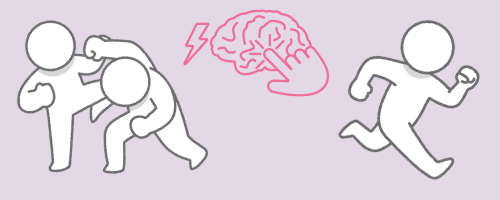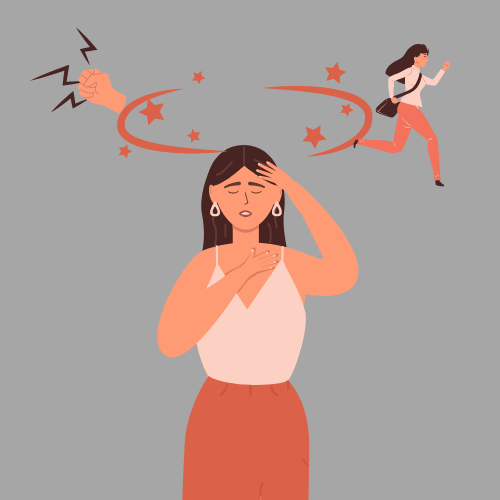The fight-or-flight response is an innate physiological reaction to a perceived threat or stressful trigger. Automatic events within the body and sympathetic nervous system increase adrenaline and noradrenaline to prepare individuals to either fight or flee from danger.

The stages of response include:
- Alarm: Alarm is the initial response to a threat when the body prepares to fight or flee.
- Resistance: During this stage, the body attempts to recover and normalise processes following the threat.
- Exhaustion: Individuals may feel exhausted after the body returns to equilibrium following a threat.
Evolution of the Fight-or-Flight Response
The fight-or-flight response has evolved as a survival mechanism to threats in the natural environment. Early humans faced many challenges, such as large predators and natural disasters.
It provided an adaptive advantage, allowing them to mobilise their energy reserves and respond to danger.
However, less dangerous events, like work or relationship stress, can trigger the fight-or-flight response in modern society.
Constant exposure to these stressors can negatively impact health. Nonetheless, this response remains a critical physiological process that protects us from danger.
What Happens to the Body?
Some may ask, “What does fight-or-flight feel like?” In short, the fight-or-flight response activates the sympathetic nervous system, thus increasing heart rate, blood pressure, breathing, and sweat. The body produces stress hormones, such as cortisol and adrenaline, to provide an extra burst of energy and focus during a perceived crisis. For example, this reaction can be lifesaving when coming accross a dangerous animal or escaping a fire.
Physical and mental fight-or-flight response symptoms include:
- Increased circulation: Blood flow to muscle groups needed for movement increases to prepare the body to fight or flee.
- Dilated pupils: Pupils dilate during fight-or-flight mode to allow increased focus and visual perception of incoming threats.
- Racing heart: Increased heart rates to pump more oxygen and nutrients to the muscles, preparing the body for action.
- Impaired bladder control: The body prioritises survival functions and may temporarily suppress non-essential bodily functions, including bladder control. This can result in difficulty controlling urine.
- Blunt pain response: The body releases endorphins and other stress hormones to suppress pain, allowing individuals to focus on the immediate threat without being hindered by pain signals.
- Flushed skin: Can cause blood vessels to dilate, leading to increased blood flow and a flushed appearance of the skin.
- Feeling on edge: Heightened vigilance and hyperawareness. These reactions can result in feeling on edge, highly alert, and sensitive to potential threats.
- Feeling tense: Muscle tension as a readiness for action, manifesting as a general tension or tightness.
- Impaired cognition: The body directs resources toward immediate survival, possibly impairing higher cognitive functions like decision-making, problem-solving, and memory retrieval.
Examples
The fight-or-flight response can occur in various real-life situations. Any scary, uncertain, or unexpected event can enact an automatic reaction, whether a social presentation, job interview, or imminent accident. As mentioned, fight-or-flight evolved to protect us from danger, but modern inconveniences or irrational fears can also trigger this biological response.
Below are examples of the fight-or-flight response:
- Giving a presentation: Many people experience increased heart rate, sweating, and alertness when speaking in front of a large audience, as the body perceives the situation as a potential threat.
- Slamming on the brakes when driving: When faced with a sudden hazard on the road, such as a car pulling out in front of you, the fight-or-flight response can activate, causing a quick reaction to hit the brakes and avoid a collision.
- Encountering a dangerous animal: When confronted by a wild animal, the fight-or-flight response prepares the body to confront (fight) or flee from the threat (flight).
- Being in a physical altercation: In situations where physical violence is imminent, the fight-or-flight response triggers increased strength and speed to protect oneself or flee.
- Witnessing or experiencing a traumatic event: Traumatic events like accidents, natural disasters, or violence can cause a fight-or-flight response.
- Taking a high-stakes exam: Facing a challenging exam or test can activate the fight-or-flight response, leading to symptoms like racing thoughts, increased alertness, and physical tension.
Why Is the Fight or Flight Response Important?
The fight-or-flight response plays a role in ensuring survival in potentially dangerous situations. The increased heart rate, elevated blood pressure, heightened alertness, and release of stress hormones help enhance physical strength, speed, and focus, enabling individuals to respond to perceived threats.
Can the Fight or Flight Response Be Harmful?
The fight-or-flight system is a normal stress response, and individuals should not be concerned if they experience activation when facing difficult situations. However, being in constant fight-or-flight mode can leave you vulnerable to physical and mental health complications or you could find yourself stuck in survival mode.
For example, people with histories of childhood trauma or anxiety disorders are at risk of problems. They may feel stuck in fight-or-flight mode, as even imaginary stressors can trigger a bodily response. In turn, consistently feeling on edge, hypervigilant, or restless can lead to health problems, chronic stress, and worsening symptoms.
Below are possible complications of an overactive fight-or-flight response:
- Anxiety disorders: Chronic activation can contribute to the development of anxiety disorders, such as generalised anxiety disorder, panic disorder, and post-traumatic stress disorder.
- Cardiovascular issues: Prolonged activation can lead to increased heart rate, elevated blood pressure, and excessive release of stress hormones, which may contribute to cardiovascular problems like hypertension and heart disease.
- Digestive problems: The body diverts blood flow from the digestive system, potentially leading to digestive issues like stomachaches, indigestion, and irritable bowel syndrome (IBS).
- Weakened immune system: The fight-or-flight response can suppress the immune system, making individuals more susceptible to infections, illnesses, and slower healing.
- Insomnia and sleep disturbances: The arousal state associated with an overactive fight-or-flight response can interfere with sleep patterns, leading to insomnia or disrupted sleep.
- Mood disorders: Chronic stress can contribute to the development of mood disorders like depression and dysthymia.
- Fatigue and exhaustion: The stress response can drain energy reserves, leading to chronic fatigue, exhaustion, and burnout.
PTSD & Fight-or-Flight
Post-traumatic stress disorder (PTSD) is closely linked to the fight-or-flight response. When individuals experience a traumatic event, such as a physical assault, natural disaster, or combat, the fight-or-flight response activates as a natural survival mechanism. In the case of trauma, the “flight” response can be an instinctual desire to escape the situation. However, when escape is impossible, individuals may find themselves stuck in hyperarousal, living in a prolonged fight-or-flight mode.
In those with PTSD, the fight-or-flight response remains constantly activated, even in non-threatening situations. This chronic state of arousal can lead to characteristic symptoms of PSTD, such as hypervigilance, intense anxiety, anger, and difficulty sleeping. For example, re-experiencing trauma memories or situations can trigger intense emotional and physiological responses, perpetuating the cycle of fight-or-flight.
How to Calm the Fight-or-Flight Response
Being always in fight-or-flight mode is dangerous for your overall well-being. Fortunately, you can take steps to calm your body and get out of survival mode when experiencing an overactive response. Consider implementing stress management skills, grounding practices, and mindfulness into your daily routine. Additionally, seek support from loved ones or ask for advice about how to handle specific situations. Sometimes, gaining an outside perspective can change how you view your circumstances and develop solutions.
Here are 11 ways to calm the fight-or-flight response:
- Use grounding techniques: Grounding techniques can help anchor you in reality and alleviate the intensity of fight-or-flight.
- Take deep breaths: Deep breathing exercises, like diaphragmatic breathing, can activate bodily relaxation responses, slowing down heart rate and promoting a sense of calm.
- Reach out for support: Don’t hesitate to seek support from friends, family, or a therapist. Talking about your feelings and experiences can help regulate the fight-or-flight response and relieve symptoms.
- Practice mindfulness: Mindfulness practices, such as meditation or yoga, can help redirect attention from anxious thoughts to the present moment.
- Engage in self-care: Prioritise activities that promote relaxation and well-being, like taking a bath, listening to soothing music, or engaging in hobbies. Self-care can help soothe the body and mind, reducing the fight-or-flight response.
- Limit exposure to stress: Identify and minimize triggers that elicit stress and anxiety. For example, setting boundaries, practicing time management, or changing your environment can create a sense of safety.
- Focus on finding solutions: Instead of dwelling on problems that activate the fight-or-flight response, focus on finding practical solutions. Taking proactive steps toward resolving challenges can help alleviate stress and anxiety.
- Take in your surroundings: Losing focus of our surroundings is easy when in fight-or-flight mode. Notice the trees, colors, sounds, and sights around you to help ground you in the present and reduce stress.
- Remind yourself that you are safe: Take a second to tell yourself, “I am safe.” Sometimes, repeating healing mantras like this can help you feel more secure. The danger has passed, and you can relax.
- Engage in regular stress management: Returning to a healthy baseline is easier when you can calm your body and mind. Practice preventive stress management by getting enough sleep, eating nutritious food, practicing relaxation techniques, and developing coping skills.
- Get moving: Exercise offers an outlet for pent-up energy and adrenaline. For example, do jumping jacks, walk around the block, or hit a punching bag when stressed or anxious. Doing so will help redirect the energy toward something constructive.
When to Seek Professional Support
In most instances, the fight-or-flight response is no cause for concern. However, consider seeking professional help if you struggle to relax or cope with stress. Feeling constantly on edge or anxious can impact your ability to function, so early intervention is essential. Avoid waiting until you feel overwhelmed by stress to seek support–start healing your body and mind early to prevent future issues.



